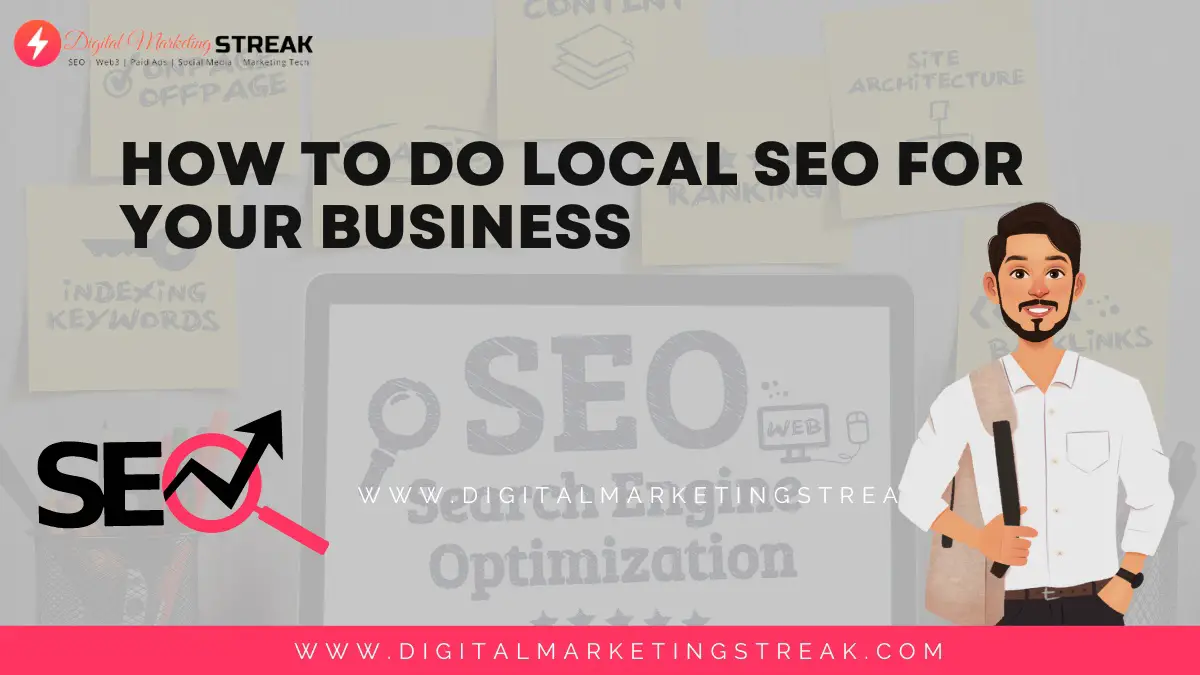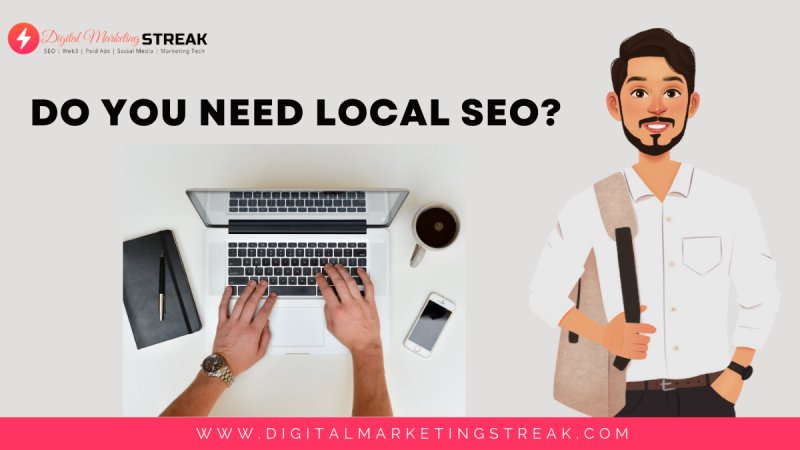Local SEO is the most important marketing strategy for your business if a huge chunk of your target market resides locally, near your own business. Studies show 46% of all Google searches inquire about local information! Local SEO will help more and more potential customers on the internet find, recognize, trust, and deal with your business, ultimately helping you with better marketing and profitability.
However, SEO can be expensive. Even beginner SEO experts charge around $50/hour to get your business started with local SEO. While this does bring up positive results, many startups can’t afford to hire SEO specialists at the beginning of their venture.
This is why today I’ll show you how you can do local SEO for your business yourself! In just 9 steps, your business can enjoy effective local SEO. This means ranking at the top of SERPs for local keywords, optimizing online directories, creating a beginner local SEO strategy, and much more!
Let’s get started!

Do You Need Local SEO?
You need local SEO more than any marketing technique if your business has a big share of the target market residing locally near your business.
Practising local SEO refers to ranking your business better for Google searches targeting your locality. ‘Best barbers near me’ or ‘Best barbers in Houston are examples of local searches.

Local SEO will help your business target these local searches and rank higher on SERPs, connecting with the local leads for your business.
Local SEO can help with the following sales and marketing aspects:
- Better local business recognition
- Improvement in on-foot traffic to your store’s physical location
- Better online presence
- Improvement in local market share
- Increase in trust and local brand awareness
For these reasons, if your business has potential customers living close to your shop, it is best to do local SEO for your business and attract all the local customers present near you.
9 Steps To Effective Local SEO
SEO can be difficult and complex. However, starting out with local SEO isn’t all that complicated.
The truth is, it will take you some hours to complete this checklist. But with just these 9 steps, you should instantly see exponential growth in your local sales and SEO.
Let’s get started.
Step #1 Setting Up Google My Business
The most essential and first step for local SEO is listing your business on Google My Business (GMB).
Listing your business on GMB helps Google recognize that your business exists. The listing process also requires details of your business that can help Google understand better what your business is about and help you rank better on searches relating to your business.
- To list your business on GMB, go to Google My Business.
- Now click on Add your business to Google.
- Google will now ask questions about your business, which you should fill in with accurate, complete, and true information.
This includes:
- Your business name
- Your store/office address
- Pin location on Google Maps
- Business Category
- Business phone number and website
- Once you’re done filling out your business info, Google will verify your business through a phone call or post. Upon verification, your listing will go live.
How To Optimize GMB
Listing your business on Google wouldn’t be enough. If you need results, you need to optimize your Google listing.
Here is what you can do.
- Upload photos of your office/store
- Mention your business hours
- List categories related to your business
- Provide additional contact information
- Create an FAQ
- Be interactive by replying to user questions and reviews
Every once in a while, you should update the content on your listing. This could refer to uploading more photos, providing more information, and replying to user queries actively.
Step #2 Listing On Online Directories With Consistent NAP
GMB is an online directory that lists businesses online.
However, there are many other major online directories that fulfill the same purpose.
To get the best recognition from Google, your business should be listed on the major online directories.
For all listings, your business information should follow consistent NAP (Name, Address, Phone Number).
Once done with the major online directories, find some local online directories and list your business there as well.
Don’t do it too much! Google never likes spamming.
Step #3 Creating A Social Media Presence
An active and interactive social media presence can do wonders for your business! This is why, your business should exist on all the major social media platforms such as Facebook, Instagram, Twitter, etc.
Social media profiles can help with the following:
- Marketing your business on online platforms
- Collecting customer reviews and adapting
- Better local SEO recognition from Google
Make sure to update your social media profiles regularly. If possible, post content that is targeted toward the local audience that you’re attempting to attract.
Step #4 Mobile Optimization Is The Key To Success
Uberall’s study shows 82% of local ‘near me’ searches are conducted from mobile phones.
60% of these users directly call a business from the search results.
So if you’re trying to target the local market, your website should be optimized proficiently for mobile phone users.
Here are some tips on how you can improve the local SEO for your website to target mobile phone users:
- Add Click to call button on GMB and your own website.
- Ensure your site speed is fast for mobile phone users (check here).
- Use bigger fonts and smaller images or any other kind of fluff or filler.
- Ensure the website’s mobile phone UI is attractive and seamless.
- Audit your website for mobile resolutions and work thoroughly on debugging.
Step #5 Create An SEO Strategy Which Targets Local Keywords
Targeting keywords (the phrases Google users commonly search for) is the most effective way to rank up on Google SERPs.
But since you’re attempting to win the local market, you should focus on local keywords (keywords related to your business that your target market uses locally) and try to rank on them.
Here is how you can achieve this.
- Search up competitor keywords. Use a tool like Ahrefs or Semrush and generate a list of local keywords related to your business.
- Prioritize keywords that have a high density and low competition, but stay focused on high-density keywords with high competition as well.
- Now search up keyword variations that you can win as well. Keyword variations are Google searches that ask the same question but in a different way. For example, ‘best barber in Seattle’ is a keyword variation to ‘top reviewed barbers Seattle’. You should focus on all keyword variations.
- Once your keyword research is done, filter out the best keywords (should be a long list) and start working on uploading content that features these keywords.
- Avoid keyword spamming and get a content writer, if feasible, to improve the likelihood of ranking on these keywords.
- Lastly, using the tools mentioned above, take a look at where your competitors are getting backlinks from. If these backlinks are helping them rank on top, you should try to get similar backlinks for your website as well.
Step #6 Starting Producing Local Content, Pages, And Social Media Posts
Now that your keyword research is done, start producing and uploading content that is naturally rich with these keywords.
This includes:
- Optimizing Web Content using local keywords
- Creating local pages on your website
- Uploading blog posts rich with organic keywords
- Uploading social media posts, featuring local keywords in descriptions, targetted towards the local audience
Local pages are parent or secondary pages on your website that are dedicated to a location. These pages have content that is rich with local keywords and has information relevant and targetted toward the local audience.
For example, this is a local page on Hallerent’s website targeting Lancaster’s audience.
Step #7 Local Link Building
Link building is extremely important in SEO. If your website has backlinks, Google will trust your website as a verifiable source and increase your chances to rank higher on Google SERPs.
But, when doing local SEO, you need backlinks from websites that are also related to the local audience you’re targeting.
A backlink from a big company in England wouldn’t do as well for local SEO as a backlink from a travel guide blog related to the location you’re targetting.
Here’s what you need to do:
- Get the word around for your website and get backlinks from all the websites that you can. These include online listings, trade associations, government websites, and educational websites.
- Contact local businesses or businesses producing content related to your location and approach them for guest posting, guides, or partnerships.
A major website writing a travel guide about your city and including your business’s website would do wonders for local SEO.
- Thirdly, try to participate in the local community. Host events or be a guest at major events that could get your business’s name on the internet. Whether it be in the form of a news article or a blogger covering that event.
Step #8 Start Working On Generating Positive Reviews
Google gets smarter day by day. In today’s age, Google can understand if your website is getting good reviews and can rank your accordingly. This is why it is important to work on generating positive reviews.
- Create easy and incentivized feedback outlets to encourage customers to leave reviews (follow-up emails, social media posts, offering rewards on reviews, etc.)
- Be diverse in getting reviews. Your website should have positive reviews on many listings. These include GMB, social media profiles, and online directories (e.g. Yelp).
- Be interactive with reviews by leaving replies. Thank positive reviewers and reply to negative reviews with helpful solutions and apologies.
Step #9 On-Page SEO Audit
The 8 steps mentioned above should build a powerful and strong foundation for local SEO. Now you need to make sure your website individually is strong enough for high SEO rankings.
This process is also called On-Page SEO.
Effective and regular On-Page SEO will help you earn and maintain high SERP rankings.
- SEO Audit: If you can afford it, consider hiring an SEO consultant to audit your website, identifying all the problems your website has relating to SEO and advising on how to fix them.
- Keyword Mapping: Each webpage should have a target keyword mentioned more than a couple of times, relevant to what the page is about.
- Title, Metas, and Slugs: Each page should have an SEO title, an SEO meta description, and concise URL slugs.
- Content: The content throughout the website (web content, blogs, copies, etc.) should be keyword and SEO optimized. The content should also serve the purpose of being informative, natural sounding, and easily readable. Local content should be targeted mainly to the local audience.
- Internal Links: Pages should have internal links connecting the different pages of the website together to aid user navigation.
- SEO-Optimized Images: All images should be relevant, featuring keyword-targetted alt text, and compressed to a small size.
Conclusion
That’s all you need to do for a strong local SEO for your business.
These 9 steps should help your business improve its local SEO rankings, leading to more sales and profits. Interested in more? Check out my Complete SEO Checklist which is guaranteed to improve your local SEO.

